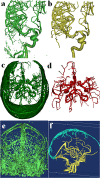Intracranial vasculature 3D printing: review of techniques and manufacturing processes to inform clinical practice
- PMID: 32761490
- PMCID: PMC7409717
- DOI: 10.1186/s41205-020-00071-8
Intracranial vasculature 3D printing: review of techniques and manufacturing processes to inform clinical practice
Abstract
Background: In recent years, three-dimensional (3D) printing has been increasingly applied to the intracranial vasculature for patient-specific surgical planning, training, education, and research. Unfortunately, though, much of the prior literature regarding 3D printing has focused on the end-product and not the process. In addition, for 3D printing/manufacturing to occur on a large scale, challenges and bottlenecks specific to each modeled anatomy must be overcome.
Main body: In this review article, limitations and considerations of each 3D printing processing step, as they relate to printing individual intracranial vasculature models and providing an active clinical service for a quaternary care center, are discussed. Relevant advantages and disadvantages of the available acquisition techniques (computed tomography, magnetic resonance, and digital subtraction angiography) are reviewed. Specific steps in segmentation, processing, and creation of a printable file may impede the workflow or degrade the fidelity of the printed model and are, therefore, given added attention. The various available printing techniques are compared with respect to printing the intracranial vasculature. Finally, applications are discussed, and a variety of example models are shown.
Conclusion: In this review we provide insight into the manufacturing of 3D models of the intracranial vasculature that may facilitate incorporation into or improve utility of 3D vascular models in clinical practice.
Keywords: 3D printing; Cerebral angiography; Intracranial vasculature; Patient specific models.
Conflict of interest statement
The authors declare that they have no competing interests.
Figures





Similar articles
-
3D-printed patient-specific applications in orthopedics.Orthop Res Rev. 2016 Oct 14;8:57-66. doi: 10.2147/ORR.S99614. eCollection 2016. Orthop Res Rev. 2016. PMID: 30774470 Free PMC article. Review.
-
3D Printing Applications for Radiology: An Overview.Indian J Radiol Imaging. 2021 Jan;31(1):10-17. doi: 10.1055/s-0041-1729129. Epub 2021 Jun 1. Indian J Radiol Imaging. 2021. PMID: 34316106 Free PMC article. Review.
-
A practical guide to cardiovascular 3D printing in clinical practice: Overview and examples.J Interv Cardiol. 2018 Jun;31(3):375-383. doi: 10.1111/joic.12446. Epub 2017 Sep 25. J Interv Cardiol. 2018. PMID: 28948646 Review.
-
Radiological Society of North America (RSNA) 3D printing Special Interest Group (SIG): guidelines for medical 3D printing and appropriateness for clinical scenarios.3D Print Med. 2018 Nov 21;4(1):11. doi: 10.1186/s41205-018-0030-y. 3D Print Med. 2018. PMID: 30649688 Free PMC article.
-
Three-dimensional printing of X-ray computed tomography datasets with multiple materials using open-source data processing.Anat Sci Educ. 2017 Jul;10(4):383-391. doi: 10.1002/ase.1682. Epub 2017 Feb 23. Anat Sci Educ. 2017. PMID: 28231405
Cited by
-
Medical 3D Printing Using Desktop Inverted Vat Photopolymerization: Background, Clinical Applications, and Challenges.Bioengineering (Basel). 2023 Jun 30;10(7):782. doi: 10.3390/bioengineering10070782. Bioengineering (Basel). 2023. PMID: 37508810 Free PMC article. Review.
-
GRAVEN: a database of teaching method that applies gestures to represent the neurosurgical approach's blood vessels and nerves.BMC Med Educ. 2024 May 7;24(1):509. doi: 10.1186/s12909-024-05512-0. BMC Med Educ. 2024. PMID: 38715008 Free PMC article.
-
The Role of 3D Printing in Planning Complex Medical Procedures and Training of Medical Professionals-Cross-Sectional Multispecialty Review.Int J Environ Res Public Health. 2022 Mar 11;19(6):3331. doi: 10.3390/ijerph19063331. Int J Environ Res Public Health. 2022. PMID: 35329016 Free PMC article. Review.
-
The Integration of 3D Virtual Reality and 3D Printing Technology as Innovative Approaches to Preoperative Planning in Neuro-Oncology.J Pers Med. 2024 Feb 7;14(2):187. doi: 10.3390/jpm14020187. J Pers Med. 2024. PMID: 38392620 Free PMC article.
-
Additive Fabrication of a Vascular 3D Phantom for Stereotactic Radiosurgery of Arteriovenous Malformations.3D Print Addit Manuf. 2021 Aug 1;8(4):217-226. doi: 10.1089/3dp.2020.0305. Epub 2021 Aug 4. 3D Print Addit Manuf. 2021. PMID: 36654837 Free PMC article.
References
Publication types
LinkOut - more resources
Full Text Sources
